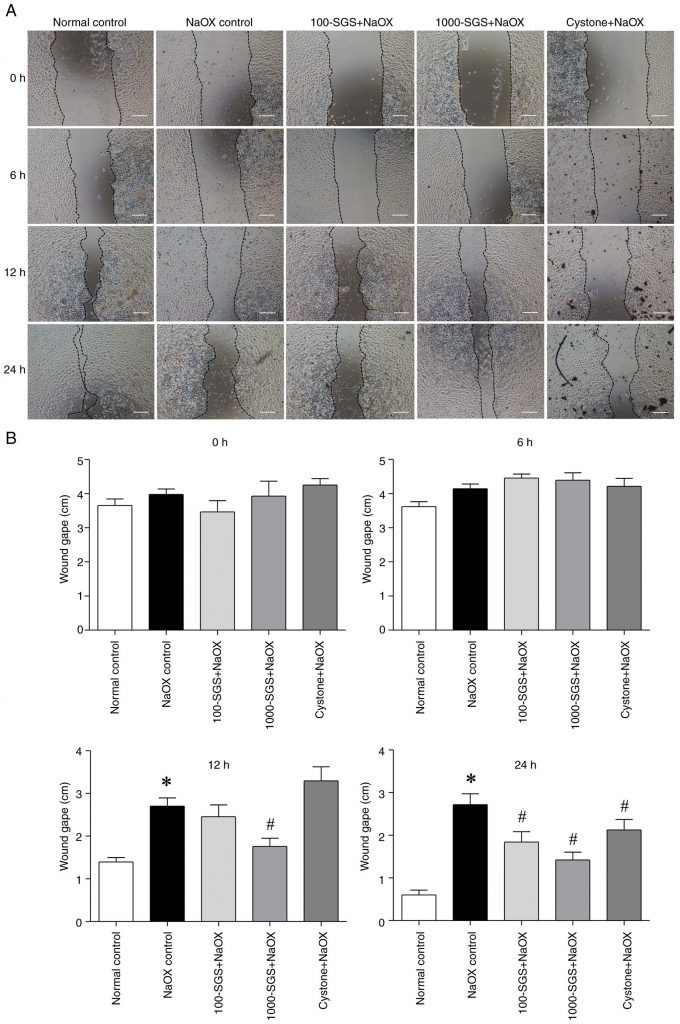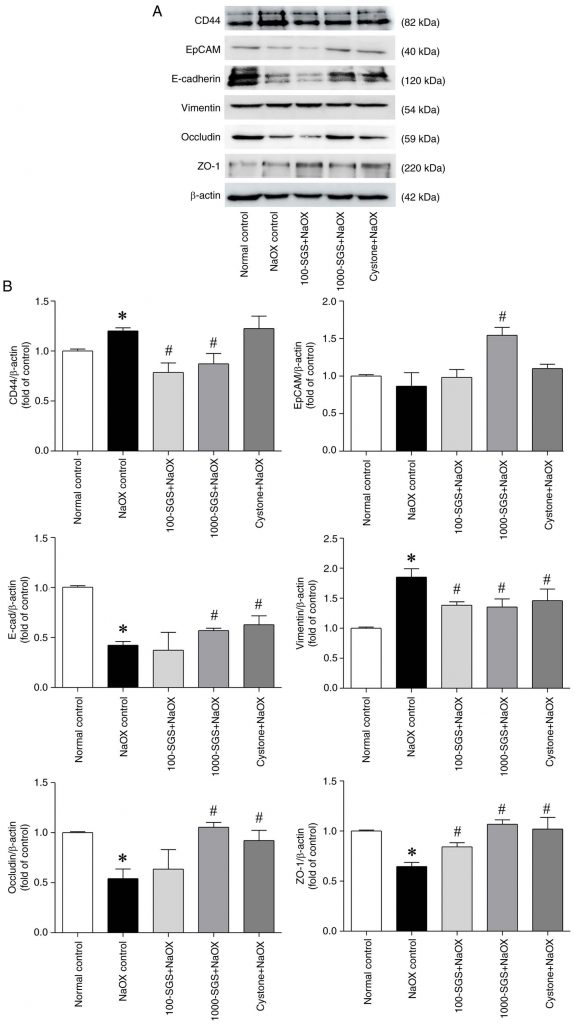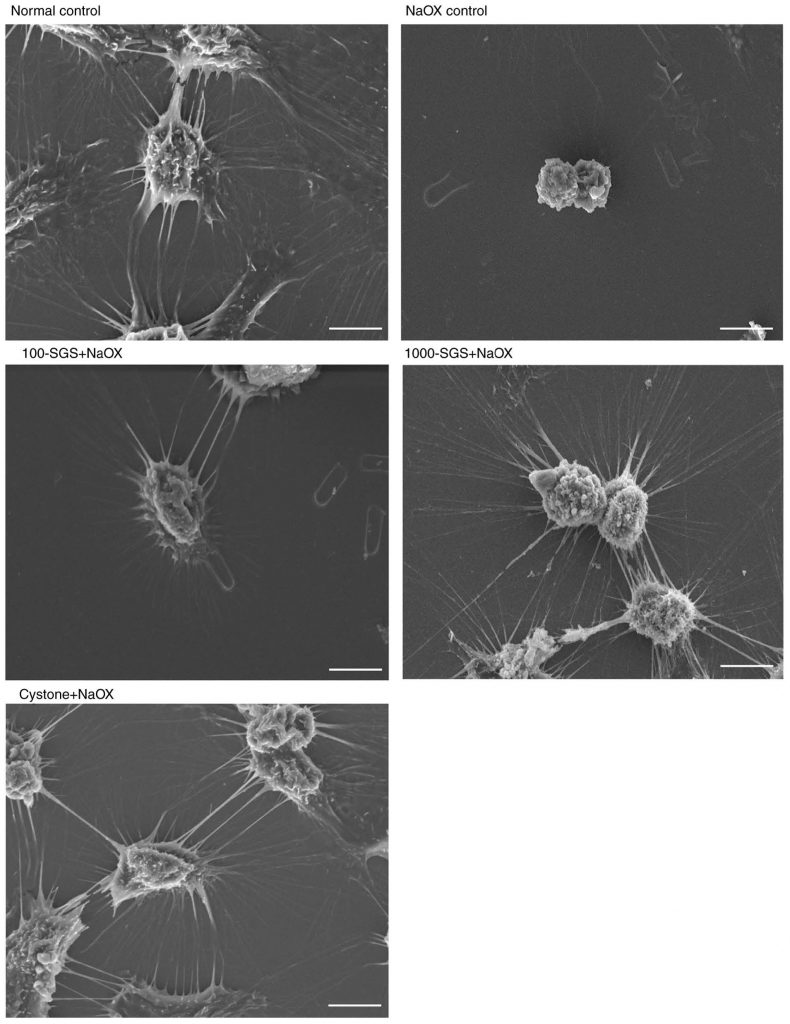


Highlight
ซัลเฟตกาแลคแตนที่เพิ่มระดับการซัลเฟต (SGS) จากสาหร่ายแดง Gracilaria fisheri แสดงฤทธิ์ป้องกันความเสียหายของเซลล์ไตที่เกิดจากโซเดียมออกซาเลต (NaOX) โดยส่งเสริมการเคลื่อนที่ของเซลล์และการสมานแผล ฟื้นฟูการแสดงออกของโมเลกุลยึดเกาะระหว่างเซลล์ และควบคุมการส่งสัญญาณ PI3K/Akt และ MAPK แสดงถึงศักยภาพของ SGS ในการพัฒนาเป็นสารรักษาโรคนิ่วในไตจากธรรมชาติในอนาคต
ที่มาและความสำคัญ
โรคนิ่วในไตเกิดจากการสะสมของผลึกออกซาเลต ซึ่งทำลายเซลล์เยื่อบุท่อไต นำไปสู่การอักเสบ และสูญเสียความสามารถในการซ่อมแซมเนื้อเยื่อของเซลล์ไต ปัจจุบันยังไม่มีวิธีรักษาที่มีประสิทธิภาพสูงและปลอดภัยในระยะยาว ปัจจุบันมีความสนใจในการค้นคว้าวิจัยสารจากธรรมชาติที่มีฤทธิ์ต้านการเกิดนิ่วและช่วยฟื้นฟูเซลล์การศึกษาครั้งนี้จึงมีความสำคัญต่อการพัฒนาทางเลือกใหม่ในการป้องกันและบำบัดโรคนิ่วในไตโดยใช้สารออกฤทธิ์จากธรรมชาติที่มีความปลอดภัยสูง ซัลเฟตกาแลคแตน (sulfated galactan) เป็นพอลิแซ็กคาไรด์ที่สกัดจากสาหร่ายแดง Gracilaria fisheri ซึ่งมีรายงานว่าให้ผลทางชีวภาพที่หลากหลาย เช่น เสริมภูมิคุ้มกัน ต้านอนุมูลอิสระ และส่งเสริมการสมานแผล อย่างไรก็ตามข้อมูลเกี่ยวกับ) งานวิจัยก่อนหน้าของกลุ่มผู้วิจัยพบว่าการปรับปรุงโครงสร้างของซัลเฟตกาแลคแตนด้วยการเพิ่มระดับการซัลเฟต (SGS) สามารถลดการตายของเซลล์ไต HK‑2 ที่ถูกเหนี่ยวนำด้วยโซเดียมออกซาเลต (NaOX) และยับยั้งการก่อตัวของผลึกได้ไต งานวิจัยนี้จึงมุ่งศึกษาผลของ SGS ต่อการเคลื่อนที่ของเซลล์ การแสดงออกของโมเลกุลยึดเกาะ และกลไกสัญญาณภายในเซลล์ในสภาวะที่เซลล์ไตถูกทำลายด้วยโซเดียมออกซาเลต
Abstract
Exposure to oxalate crystals causes cellular injury and dysfunction in the renal tubular epithelium. Sulfated galactan with increased sulfation (SGS) from the red seaweed Gracilaria fisheri exhibits anti‑urolithiasis effects by inhibiting oxalate crystal formation and preventing sodium oxalate (NaOX)‑induced death of renal tubular (HK‑2) cells. However, the effects of SGS on wound healing and adhesion molecule expression in NaOX‑induced HK‑2 cell injury remain unexplored. The present study investigated the effects of SGS on wound healing and the regulation of adhesion molecule expression in NaOX‑induced HK‑2 cell damage. The findings showed that SGS promoted wound healing in HK‑2 cells following a scratch injury under NaOX‑induced conditions. NaOX exposure increased the expression of CD44 and vimentin while decreasing the expression of EpCAM, E‑cadherin, occludin and ZO‑1, as demonstrated by reverse transcription‑quantitative PCR, western blotting and immunofluorescence analysis. Treatment with SGS restored these adhesion molecule expression levels to near normal. Scanning electron microscopy revealed that SGS also reversed NaOX‑induced morphological changes in HK‑2 cells. Additionally, SGS reduced the expression of Akt and p38 while upregulating PI3K and Erk1/2 in NaOX‑treated HK‑2 cells. These results suggested that SGS enhances wound healing and regulates the expression of adhesion molecules, possibly through the PI3K/Akt and MAPK (p38 and Erk1/2) signaling pathways, highlighting the potential of SGS as a promising therapeutic compound for preventing and treating NaOX‑induced renal damage.
KEYWORDS: sulfation of sulfated galactan, cell migration, adhesion molecules, human kidney cells, sodium oxalate
Citation: Rudtanatip T, Phanphak J, Somintara S, El‑Abid J, Wongprasert K, Kovensky J, et al. Effect of Gracilaria fisheri sulfated galactan with increased sulfation on cell migration and expression of cell adhesion molecules in sodium oxalate‑induced HK‑2 cell injury. Biomedical Reports. 2025 May 22;23(2):1–15. https://doi.org/10.3892/br.2025.2001
RELATED SDGs:
SDG Goal หลัก ที่เกี่ยวข้อง
3. GOOD HEALTH AND WELL-BEING

ผู้ให้ข้อมูล: ศาสตราจารย์ ดร.กนกพรรณ วงศ์ประเสริฐ
ชื่ออาจารย์ที่ทำวิจัย: ศาสตราจารย์ ดร.กนกพรรณ วงศ์ประเสริฐ
Credit ภาพ: ศาสตราจารย์ ดร.กนกพรรณ วงศ์ประเสริฐ
Webmaster: ว่าที่ ร.อ. นเรศ จันทรังสิกุล
Tags: adhesion molecules, cell migration, human kidney cells, sodium oxalate, sulfation of sulfated galactan
